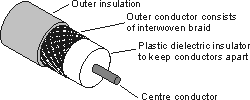Feeder Types: Coax, Balanced, Waveguide
Introduction and notes on RF feeders, describing the different types including coax and open-wire feeder and waveguide.
Home » Antennas & Propagation » this page
Coax Tutorial Includes:
RF Feeders - types
Coax cable / coax feeder
Balanced feeder
Waveguide
Feeders or transmission lines are used to transfer RF signals from one point to another. They are used in many areas, one common example of an RF feeder is the coax or coaxial cable used to connect a television antenna to the television.
These RF feeders need to have a number of properties if they are able to work well:
The loss that a feeder introduces between the antenna and receiver or transmitter is of the utmost importance. Any power that it loses will reduce the efficiency of the station. In order to reduce this low loss types of coax are almost always used at these frequencies. These coax cables are thicker than the standard types.
Types of feeder
There are several forms of feeder that can be used to transfer radio signals from one point to another. Each of these types of feeder has its own advantages and can be used to its best in different applications. They are all described in more details below:
- Coax or coaxial cable Coax cable is the most widely used radio frequency feeder being used in very many domestic and commercial applications. It consists of an inner conductor surrounded by an insulating dielectric and covered with an outer screen or braid. In turn there is a final insulation cover to act as protection. It carries current in both inner and outer conductors, but because they are equal and opposite all the fields are confined to within the cable and cannot radiate. As there are no fields outside the cable, nearby objects do not effect its properties and it can be used to carry RF energy through many locations with little risk of them being affected.

Coax cable feeder Read more about . . . . coax cable feeder. - Open wire or twin feeder: Apart from coax cable, another type of feeder that is more commonly used on frequencies below 30 MHz is called an open wire, twin feeder or ribbon. This type of feeder consists of two parallel wires. As the currents that flow in the two wires are equal and opposite, in theory no signal should be radiated from them. In practice it is found that they are affected by nearby objects and this form of feeder could not be run through a house for example. One form of this feeder is often used to make up temporary VHF FM broadcast band antennas. It is also used in the construction of some vertical antennas for VHF.
Twin feeder a form of balanced feeder Read more about . . . . balanced feeder. - Waveguide: Another form of feeder which can be used at higher frequencies, particularly in the microwave region is called waveguide. Essentially it consists of a "pipe" which is usually rectangular in cross section, although occasionally circular ones are used.
Unlike coax cable, waveguide has no centre conductor, and the way it operates is different. A signal is launched or transmitted into it and as it cannot escape through the walls it travels along the waveguide. It is found that a waveguide of particular dimensions cannot operate below a certain frequency, having what is known as a cut-off frequency. Below this no signals propagate along it. This means that a number of different sizes of waveguide are available dependent on the frequency in use. These sizes are standardised and given numbers in the form WG**. As an example, a waveguide for use between 2.60 and 3.95 GHz has internal dimensions of 72 x 34 mm and is given the designation WG10.
The main advantage of waveguide is its low loss at high frequencies compared with coax. In the case of WG10 made from aluminium it can be as low as 0.7 dB per 30 metres. Against this its cost is much higher.
Read more about . . . . waveguide.
Summary
Each type of feeder has its own advantages and disadvantages, but of the three, it is coax cable that is used by far the most. It is easy and convenient to use and it is not affected by nearby objects. This means that it can be run almost anywhere. It is also relatively cheap, and far less expensive than waveguide.
 Written by Ian Poole .
Written by Ian Poole .
Experienced electronics engineer and author.
More Antenna & Propagation Topics:
EM waves
Radio propagation
Ionospheric propagation
Ground wave
Meteor scatter
Tropospheric propagation
Antenna basics
Cubical quad
Dipole
Discone
Ferrite rod
Log periodic antenna
Parabolic reflector antenna
Phased array antennas
Vertical antennas
Yagi
Antenna grounding
Installation guidelines
TV antennas
Coax cable
Waveguide
VSWR
Antenna baluns
MIMO
Return to Antennas & Propagation menu . . .




